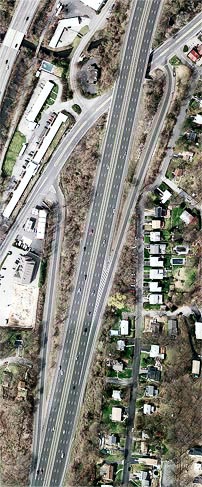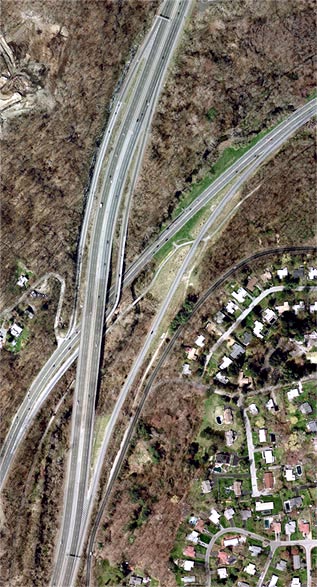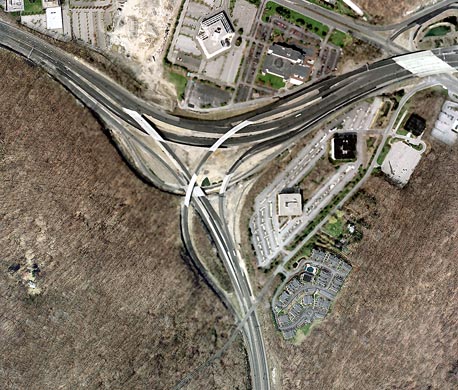Monday, 19 February 2001
 |
 |
 |
 |
Orientation: The New York State Thruway (I-87) runs from bottom to top and NY 9A (Saw Mill River Road) runs diagonally from left to top right. Also visible at top left is the Saw Mill River Parkway, which at this point bridges the river for which it is named.
Exit numbers: Continuing from Week 16 along the New York State Thruway, the next interchange is Exit 7 for NY 9A to Dobbs Ferry and Ardsley.
The interchange: This is a half-diamond interchange providing
connections to and from the south only, matching prevailing commute
patterns.
Orientation: The New York State Thruway (I-87) runs bottom to top, while the Saw Mill River Parkway runs diagonally from bottom left to top right. NY 9A (Saw Mill River Road) enters alongside the Thruway at bottom, then curves away to the right. It continues generally parallel to the Saw Mill River and Taconic Parkways toward Elmsford and Briarcliff Manor. Mountain Road intersects the Saw Mill River Parkway at left center.
Exit numbers: Exit 7A (Saw Mill River Parkway) is signed from the northbound Thruway for Elmsford and Katonah, and from the southbound Thruway for Yonkers and New York.
From the Saw Mill River Parkway northbound, Exit 20 is for the New York State Thruway (I-87), north only. From the southbound parkway, Exit 20 is the at-grade junction with Mountain Road.
The interchange: In the New York metropolitan area, expressways (carrying mixed passenger and commercial traffic) often run parallel to parkways (carrying only passenger cars). Often, interchanges between the two will provide connections for same-direction travel only (e.g., northbound to northbound), since reverse-direction movements would be essentially redundant. The New York State Thruway and the Saw Mill River Parkway share a corridor through Yonkers and Ardsley, and where they part company, Thruway Exit 7A offers just such a connection.
The northbound Thruway exit ramp offers a high-speed connection to the Saw Mill River Parkway; the southbound exit ramp is somewhat tighter and requires a stop at its base, where Mountain Road also intersects. The most interesting ramp is that from the northbound Parkway to the Thruway. The area's topography, combined with parkway height restrictions, allows this ramp to cross under the Thruway while still rising high enough to cross over the parkway immediately beyond. Here it makes a sharp curve, then provides a long acceleration lane to resume high-speed travel.
At this interchange, besides all reverse-direction movements, there
is one missing connection. That is, from the southbound Saw Mill River
Parkway to the southbound Thruway. However, this connection can be made
at Thruway Exit 8 by means of the
Cross-Westchester Expressway.
 |
|
|
Orientation: The New York State Thruway (I-87) runs from bottom to top left. The Cross-Westchester Expressway, also under the jurisdiction of the New York State Thruway Authority, enters at top right and ends at the Thruway interchange. Interstate 287 follows the Cross Westchester Expressway, and joins the Thruway mainline from this point west (left) to Suffern. NY 119 (Tarrytown Road) runs across the top right corner. The surface road crossing I-87 at bottom is Taxter Road, a Greenburgh town highway.
Exit numbers: Exit 8 on the New York State Thruway is for
I-287 to White Plains and Rye. Exit 8A, from the
southbound Thruway only, is for NY 119 and the Saw Mill River Parkway.
This interchange is unnumbered on the
Cross-Westchester Expressway, being its terminus.
The interchange: This interchange has been completely
reconstructed in recent years and is shown here substantially
complete. The new design provides multi-lane, high-speed through travel
on either I-87 or I-287. It also features new collector-distributor
roadways to segregate through traffic from that using the NY
119 and Saw Mill River Parkway interchange immediately to the east on
I-287.
(At top right, part of the westbound I-287 ramps to and from NY 119 are
visible.) It introduces Exit 8A on the southbound Thruway, which
follows the original ramp to I-287 eastbound but now only connects to
the collector-distrubutor roadway. The new southbound Exit 8 is a
high-speed left exit feeding the Cross-Westchester Expressway on the
inside. Also visible are the remains of the old
northbound Exit 8 ramp.
The interchange was originally built as a standard semi-directional T, which allows for only right-hand exits and entrances. The original ramps were set in deep rock cuts, most of which were removed with the reconstruction. An older interchange design, the directional T (see Week 8 for an example), would probably have required less excavation, since it involves left-hand exits and entrances for left-turn movements. But the New York State Thruway Authority maintains the highest standards for safety and efficiency in highway design, which has typically precluded the use of left-hand exits. This is no longer a concern with the configuration of Interstate 287 as a through highway in its own right, rather than as an exit from Interstate 87.
NOTE: Portions of the images on this page appear blurry and indistinct. This is a security measure undertaken by the NYS Office of Cyber Security & Critical Infrastructure Coordination to restrict access to imagery of certain "sensitive areas".